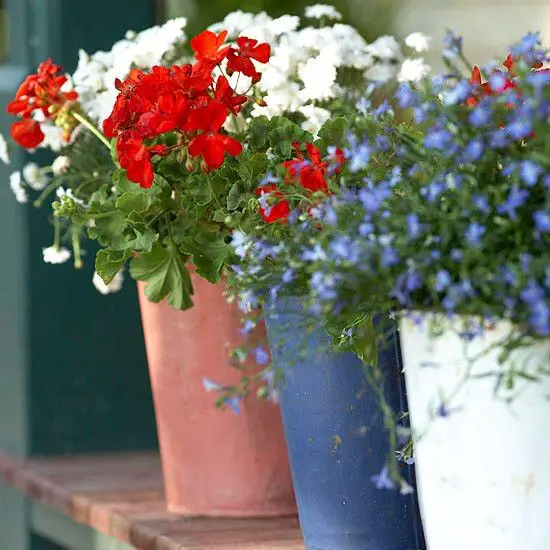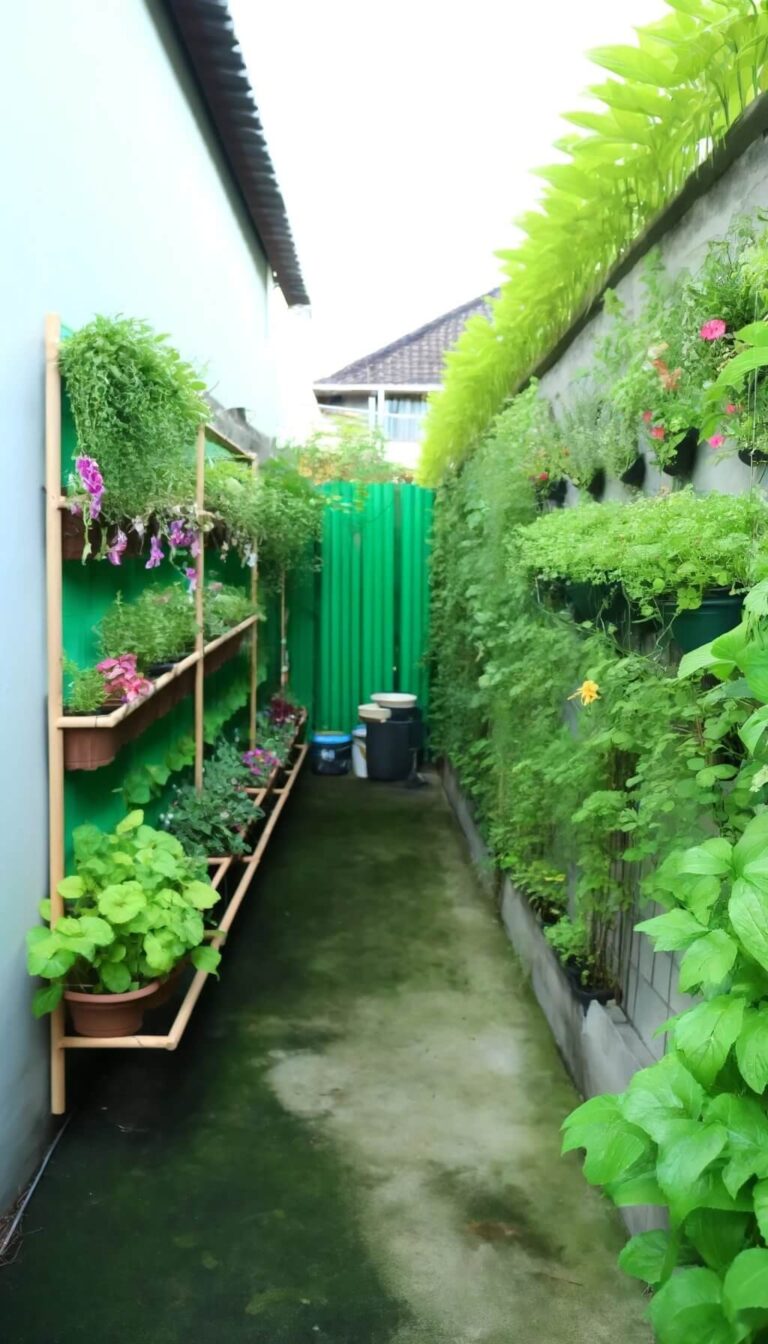Top 9 Plants That Repel Aphids: 2024 Gardeners Guide
It’s a common phenomenon – some gardens thrive, while others seem plagued by pesky aphids. But it’s not just luck that separates the two. It’s about using smart gardening techniques, specifically by incorporating plants that repel aphids. These tiny sap-suckers can wreak havoc on even the healthiest of gardens, attacking everything from roses to veggies without discrimination. However, before reaching for chemical sprays, consider this: nature has a better plan.
Plants that naturally repel aphids do exist, and they’re like the cool bouncers of the plant world – keeping those troublemakers at bay. By using these plants strategically in your garden layout, you can create a no-aphid zone without resorting to harsh methods. This way, your garden doesn’t just survive; it thrives. The key is being clever with what you plant and how you layout your garden.
By incorporating aphid-repellent plants into your design, you’ll be creating an ecosystem that’s inhospitable to these pests. And the best part? It’s a natural and sustainable approach that won’t harm the environment or put your family’s health at risk. So, ready to turn your garden into a no-aphid zone naturally? Let’s dive in and explore the world of plants that repel aphids.
Understanding Aphids
Let’s explore the world of aphids, those tiny yet troublesome pests that can wreak havoc on your garden. You’ve likely encountered them before, even if you didn’t know what they were. Aphids are notorious for their ability to feast on a diverse array of plants, leaving behind a trail of destruction in their wake. While it’s true that they can be a significant problem, the good news is that there are many effective ways to keep them under control and maintain a healthy balance in your garden.
What Are Aphids, Anyway?
Aphids, those tiny, sap-sucking pests, are notorious for their unwanted presence in gardens. Their vibrant green hue is often accompanied by shades of black, white, and pink, making them stand out like an uninvited guest at a soiree that refuses to depart. These insidious insects reproduce at an alarming rate, especially when the weather warms up, transforming a few unwelcome visitors into a full-fledged invasion in no time.
Plants on the Aphid Menu
While it may seem absurd to ponder the snacking preferences of aphids, these tiny insects are actually drawn to specific plant types. It turns out that aphids aren’t particularly picky eaters, but they do have a soft spot for certain plants that offer them an irresistible combination of sweetness, tender growth, and ease of access. In fact, some plants are more appealing to aphids than others.
For instance, roses, with their sweet sap and delicate new growth, are a major hit among aphid populations. Vegetables also rank high on the list, thanks to their soft, easy-to-pierce leaves that provide an ideal snacking surface. Fruit trees, meanwhile, offer a triple threat: plenty of sap, shelter from predators, and succulent fruit to munch on. While this may not be the most conventional culinary preference, it’s clear that aphids have a clear affinity for certain plant types.
The Trouble with Aphids
While aphids may seem harmless at first glance, they can wreak havoc on plants. One of their most significant issues is sap drainage, where they literally suck the life out of plants, potentially weakening or killing them. Additionally, these tiny pests are messy eaters, leaving behind a sticky residue called honeydew that attracts other pests and can develop into a sooty mold, giving plants an unappealing black coating.
The Role of Companion Planting
While companion planting may seem like a mystical gardening technique, its benefits are rooted in scientific principle. By strategically placing certain plants alongside one another, gardeners can create an ecosystem where each plant enhances the growth and well-being of its neighbor. In the case of deterring aphids, some plants possess natural characteristics that repel these pesky insects, effectively acting as guardians for the rest of your garden.
How Does Companion Planting Work?
Companion planting is built on a simple yet fascinating concept: harnessing the natural properties of different plants to enhance their coexistence. Some plants possess inherent traits that repel or deter pests, while others attract beneficial insects that prey upon these unwanted visitors. Additionally, certain plants can boost growth rates or flavor profiles, creating a harmonious and mutually beneficial relationship within the garden ecosystem.
For gardeners, this approach translates into reduced workload, minimized pest issues, and overall healthier and happier plants – a truly desirable outcome.
Plants That Tell Aphids to Buzz Off
When it comes to defending your garden against aphids, certain plants can be game-changers. Take marigolds for example – their potent scent acts as a secret agent, masking the aromas of other plants and keeping those pesky aphids confused and at bay. Similarly, garlic is a strong stink that aphids abhor, making it an effective deterrent against infestations. And then there’s chives, whose oniony armor not only deters aphids but also enhances the flavor of nearby plants.
These plants not only offer natural protection against aphids but also add beauty and diversity to your garden. By incorporating them into your landscape, you’re essentially setting up a defense system that works in harmony with nature.
Companion Planting in Action
To effectively use companion planting as a means of combating aphids, it’s essential to approach the process in a methodical and deliberate manner. Here’s a step-by-step guide to help you get started:First, take the time to plan your garden layout, considering which plants will work harmoniously together. Incorporating flowers like marigolds among your vegetables is an excellent starting point. Next, carefully select companion plants that are well-suited for each other.
Not all plant pairings are created equal; some can even have detrimental effects on one another. Be sure to conduct some research to ensure the plants you’re pairing are a match made in heaven. Finally, remain vigilant and observe your garden’s progress over time. What’s working effectively? What areas need adjustment? While companion planting is not an exact science, it’s crucial to be willing to adapt and try new combinations as needed.
Plants That Repel Aphids: The Herbal Heroes
In the ongoing struggle against aphid populations, certain plants have evolved to possess extraordinary defenses that deter these pests. These unsung heroes wield potent fragrances that are so overwhelming, aphids instinctively retreat in search of more hospitable environments. One such champion of natural pest control is catnip, a plant renowned for its remarkable ability to repel aphids with its pungent aroma.
Catnip

Envision a botanical superstar that not only captivates felines but also effectively repels aphids. This is the remarkable catnip, a plant whose strong, minty aroma has a profound impact on both its fans and foes. For cats, it’s a sensory delight; for aphids, it’s a deterrent so formidable they’ll think twice before approaching. The secret to catnip’s success lies in its unique chemical composition, nepetalactone, which is irresistible to cats but unpleasantly overpowering for aphids.
The potency of catnip against aphids is more than just anecdotal; scientific evidence supports the plant’s ability to repel these pests. When planted strategically around vulnerable crops or flowers, catnip functions as a natural barrier, its intense aroma overwhelming aphids and preventing them from infesting nearby plants.
This natural defense system not only safeguards sensitive vegetation but also encourages beneficial insects like bees and butterflies, which are attracted to the plant’s fragrance. What sets catnip apart in the garden is its multifaceted role. It serves as a pest repellent, a feline entertainer, and an attractant for beneficial insects – all at once. This remarkable versatility makes catnip a valuable addition to any gardening arsenal.
Planting Catnip: A Strategy Against Aphids
Discover how effortlessly you can repel aphids in your garden by incorporating catnip. This low-maintenance herb requires minimal care and yet offers impressive benefits. Whether planted in garden beds or containers, catnip is undemanding and easy to grow. By strategically placing it around the perimeter of your garden or among susceptible plants, you’ll create a natural barrier that deters aphids from feasting on your prized greens.
Chives
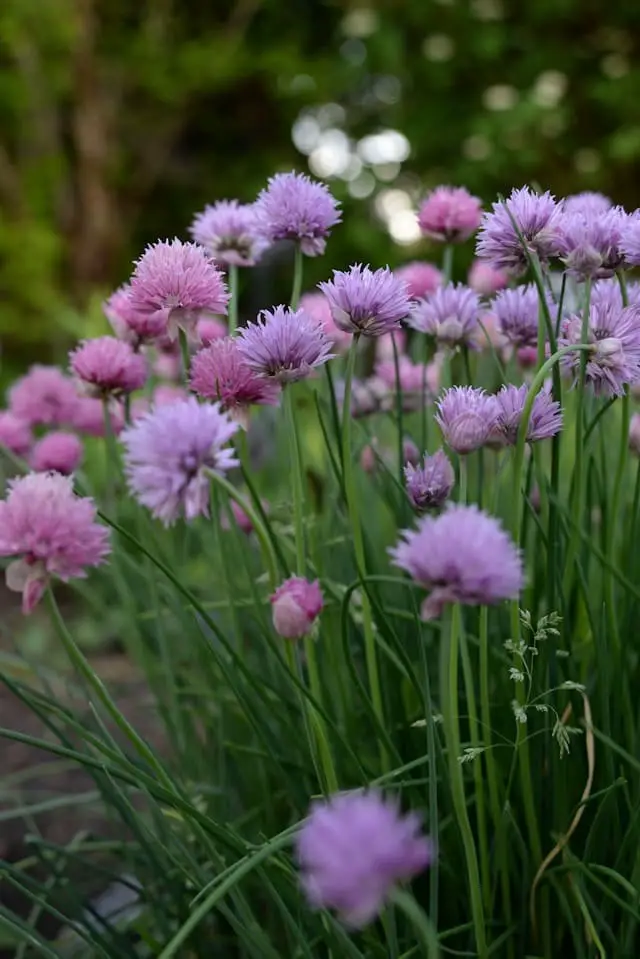
When it comes to our gardens’ secret guardians, chives stand out for their impressive track record in warding off aphids. It’s not just a matter of aesthetics or flavor; chives have evolved to repel these pesky insects through the release of sulfur compounds. These potent natural repellents are like kryptonite to aphids, rendering them powerless against the presence of chives.
As a result, chives become an essential ally in your garden’s defense system, providing an invisible shield that deters aphids from targeting your plants. Beyond mere deterrence, however, chives play a double role by enhancing the overall health of your garden ecosystem. Their strong scent masks the fragrance of other plants, making it harder for aphids to detect their next meal. Additionally, chives attract beneficial insects like ladybugs, which are natural predators of aphids.
This synergy creates a win-win scenario: you enjoy the benefits of an aphid-free garden while also promoting ecological balance. One of the most attractive aspects of chives is how effortlessly they grow and thrive. They require minimal care—simply provide them with a sunny spot and occasional watering—and will reward your efforts with lush greenery and the occasional purple bloom. For gardeners seeking a low-maintenance solution to combat aphids, chives are an excellent choice.
Garlic

When it comes to organic gardening, few natural deterrents are more effective than garlic in repelling aphids. This culinary staple’s unique combination of sulfur compounds makes it a potent ally against these pesky pests. As garlic breaks down in the soil, its sulfur-rich aroma forms a protective shield that sends aphids scrambling for a less pungent environment. This isn’t just good news for gardeners; it’s a win for anyone looking to maintain a more chemical-free garden.
Garlic’s dual role is what sets it apart from other natural pest repellents. Its sulfur compounds not only deter aphids but also have the added benefit of improving soil quality. As garlic leaves decompose, they release sulfur into the soil, which can help reduce soil-borne diseases and enhance the overall health of garden plants. Incorporating garlic into your garden is a straightforward process that requires little maintenance.
Whether you’re planting cloves around the edges of your garden or interspersing them among susceptible plants, garlic adapts well to various conditions. Its low-maintenance nature makes it an ideal choice for gardeners of all levels.
Basil
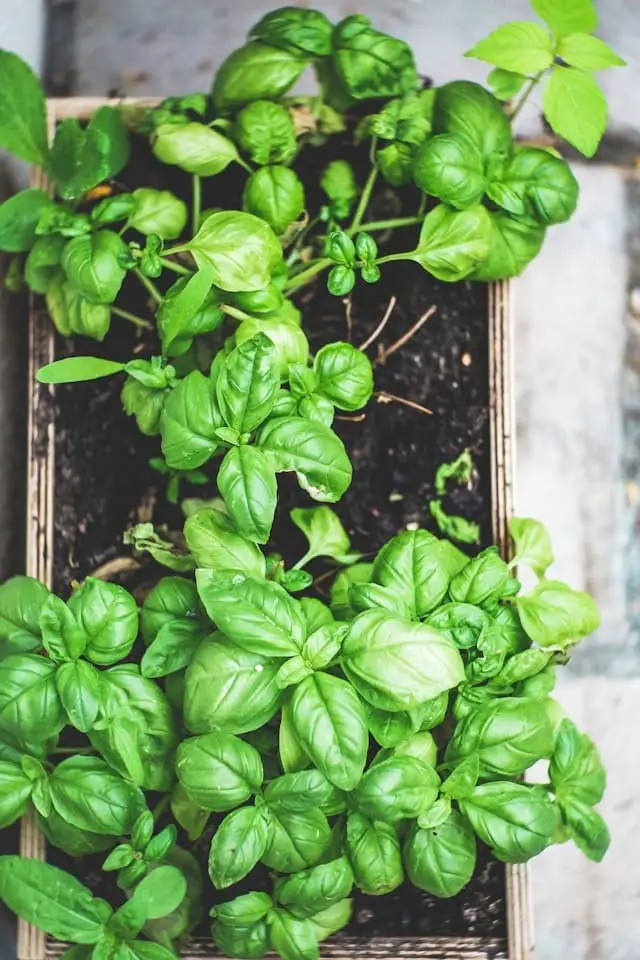
Basil, a culinary staple and natural aphid deterrent, offers a potent combination of flavors and fragrances that benefit both cooks and gardeners. This versatile herb’s leaves are rich in essential oils, including linalool, eugenol, and citronellol, which emit a scent unpleasant to aphids but pleasant to humans and beneficial insects. By incorporating basil into your garden, you can create a natural barrier against these pests, akin to erecting a ‘keep out’ sign.
The aromatic leaves also attract pollinators like bees and butterflies, fostering a balanced ecosystem. Basil’s benefits extend beyond its fragrance, as it enhances plant health by indirectly encouraging beneficial insects. This dual-action herb is an invaluable asset in the garden, contributing to both pest control and pollination. Integrating basil into your garden is straightforward: simply provide it with sunny spots, well-draining soil, and minimal care.
Whether grown among tomato plants or in pots on a patio, this adaptable ally offers a range of benefits for cooks and gardeners alike.
Flowers That Fend Off Aphids
Marigolds

The potency of marigolds stems from their potent fragrance, which is not just a pleasant aroma but also a natural repellent that confuses and repels aphids. This scent is produced by the plant’s essential oils, emitting a smell that is pleasing to humans and beneficial insects, yet unappealing to aphids.
Marigolds are surprisingly effective in their ability to deter pests without requiring special conditions or maintenance.
They thrive in various environments, provided with adequate sunlight and well-drained soil. This adaptability allows marigolds to grow effortlessly around the perimeter of your garden or among susceptible plants, creating a fragrant barrier that aphids are likely to avoid.
The benefits of marigolds extend beyond their ability to repel pests. Their strong scent masks the fragrance of other plants, making it difficult for aphids to locate their target.
The bright color of marigolds also attracts beneficial insects, increasing biodiversity and aiding in aphid control. Furthermore, marigolds are easy to grow and maintain, allowing for widespread use in aphid prevention.
Beyond Repellence: The Benefits of Marigolds
Marigolds possess a unique advantage in the garden, extending their benefits beyond simply controlling aphids. By serving as a magnet for beneficial insects like ladybugs and bees, these vibrant flowers facilitate pollination and promote natural pest control. This dual functionality makes them an indispensable component in fostering a harmonious and thriving garden ecosystem.
Integrating Marigolds into Your Garden
Incorporating marigolds into your garden plan is remarkably effortless. Whether you’re a seasoned gardener or a novice looking to learn, marigolds harmonize seamlessly with any garden design. Not only do they bring vibrant color and beauty, but they also provide valuable protection against aphids for both vegetables and flowers. By incorporating marigolds into your gardening strategy, you’re not just planting flowers – you’re investing in your garden’s overall health and resilience.
Chrysanthemums
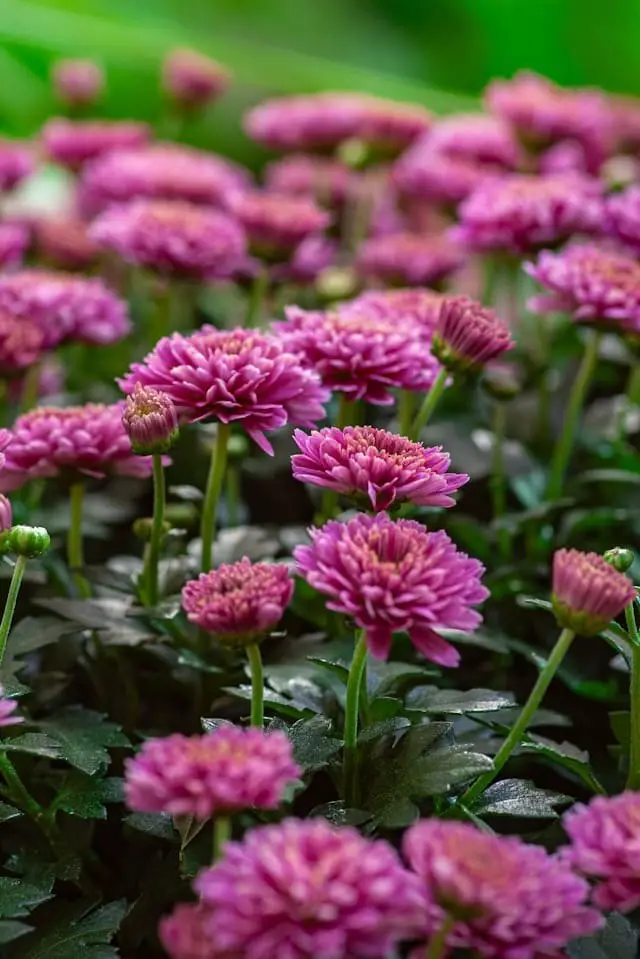
Chrysanthemums are often admired for their visual appeal, but they also play a crucial role in maintaining a healthy and balanced ecosystem. As a natural insecticide factory, these flowers produce pyrethrin, a compound that has been widely recognized for its effectiveness in pest control. This eco-friendly alternative to synthetic chemicals offers a safer and more environmentally friendly way to manage pests without harming surrounding wildlife.
Pyrethrin works by targeting the nervous systems of insects, rendering them unable to move or reproduce upon contact. Its ability to target a wide range of pests while posing minimal toxicity to mammals and birds makes chrysanthemums an essential plant in any eco-conscious gardener’s toolkit for managing pest populations.
Incorporating chrysanthemums into your garden involves more than just adding beauty; it’s about strategically positioning these natural insecticides to provide the most protection for your other plants. Whether you’re dealing with aphids on roses or caterpillars on vegetables, placing chrysanthemums nearby can help keep these pests at bay. By doing so, you’ll be encouraging garden biodiversity and reducing the overall presence of harmful pests.
Beyond Pest Control: The Benefits of Chrysanthemums
The benefits of chrysanthemums don’t stop at their ability to repel pests. These flowers also play a crucial role in supporting biodiversity by drawing in beneficial insects. This is particularly noteworthy, as pyrethrin, which can effectively deter harmful pests, poses relatively little risk to pollinators like bees and butterflies when used responsibly.
As such, incorporating chrysanthemums into your garden design allows for the creation of a thriving ecosystem where beneficial insects and other species can coexist harmoniously.
Nasturtiums
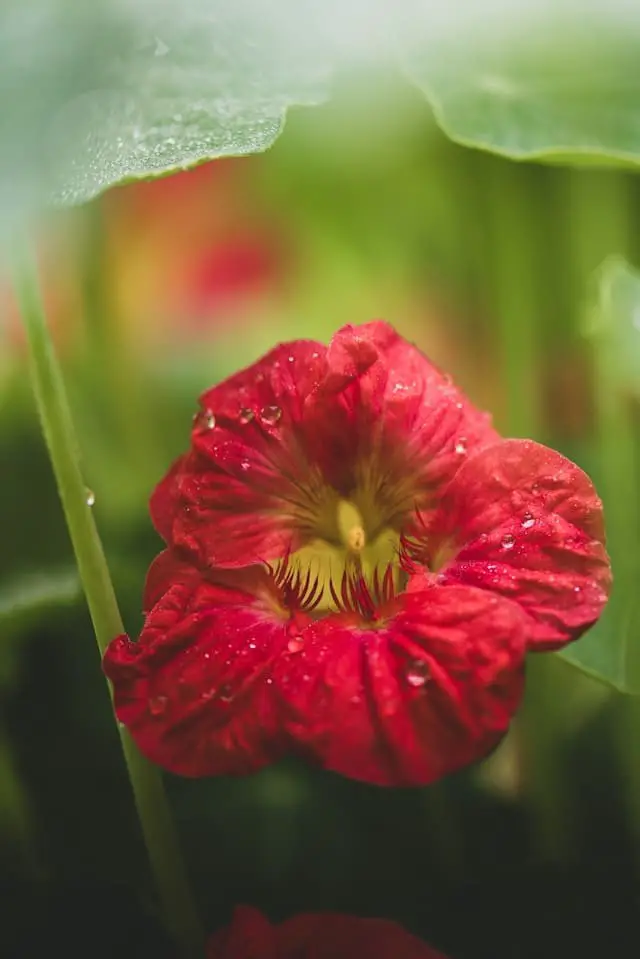
In the art of strategic gardening, nasturtiums play a crucial role as an unsung hero. By acting as a trap crop, they cleverly distract aphids away from more valuable plants, providing a natural and surprisingly simple method of pest management.
The allure of nasturtiums lies in their vibrant flowers and lush foliage, which serve as a beacon to aphids.
The reason this tactic is so effective is twofold: the soft, succulent leaves of nasturtiums are particularly appealing to aphids, while they also emit a fragrance that draws these pests in.
Once aphids settle on nasturtiums, they become less likely to infest other plants, effectively safeguarding the majority of your garden. This natural pest control method harnesses the inherent behavior of pests to the gardener’s advantage, reducing the need for chemical interventions.
Implementing nasturtiums as a trap crop is as straightforward as planting them around the perimeter of your garden or interspersing them among the plants you want to shield from aphids. This creates a first line of defense, luring aphids away from more valuable crops and keeping your garden safe.
The benefits of using nasturtiums as a trap crop include: high aphid attraction, vibrant color, soft leaves that are very appealing to aphids, fragrance that attracts aphids and enhances the trap effect, and a garden benefit in drawing aphids away from main crops.
Beyond Aphid Control: The Advantages of Nasturtiums
Nasturtiums are multifaceted wonders in the garden, offering a trifecta of benefits beyond their impressive aphid-trapping abilities. The leaves and flowers of these plants possess a delightful peppery flavor, making them a tasty addition to salads and dishes. Not only do they provide an edible treat, but nasturtiums also serve as magnets for beneficial insects like pollinators, boosting the overall health and productivity of your garden.
This dual-purpose charm makes them an essential component in any garden seeking harmony between aesthetics, utility, and environmentally friendly pest management.
Vegetables in the Aphid Battle
Onions
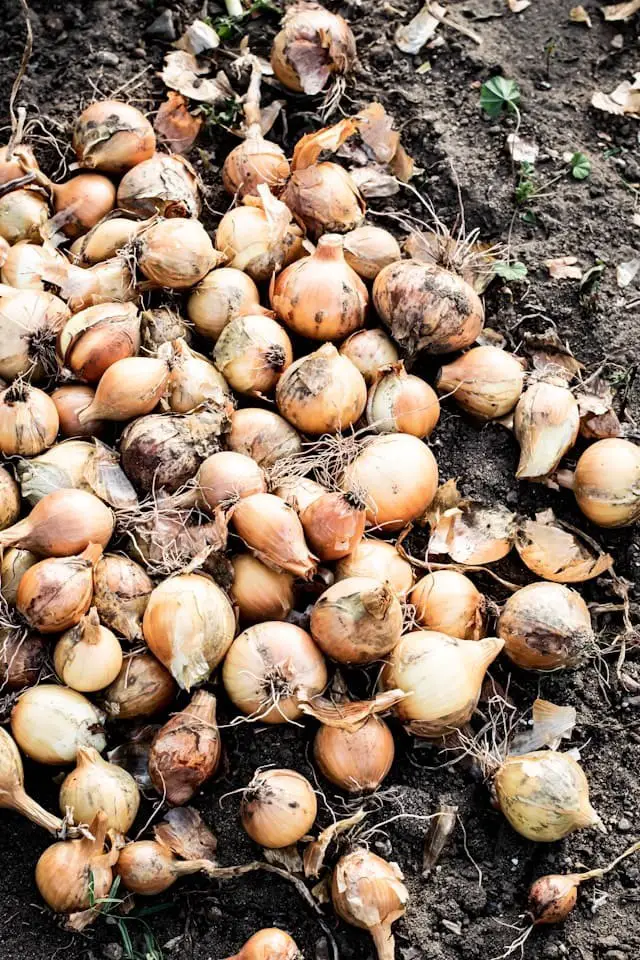
Onions are often overlooked as a simple kitchen staple, but they possess a remarkable ability to aid in pest control. Their strong scent and sulfur compounds make them an effective natural deterrent against aphids, offering a dual-threat against these pesky insects. The pungent aroma of onions not only masks the smell of more desirable plants, but also confuses aphids searching for their next meal, much like having a natural guard patrolling your garden.
Additionally, the sulfur compounds found in onions play a crucial role in repelling aphids by creating an inhospitable environment that’s difficult for them to thrive in. This natural defense mechanism eliminates the need for chemical pesticides and supports a healthier ecosystem. Incorporating onions into your garden is straightforward – simply plant them around the perimeter or intersperse them among susceptible plants to create a protective barrier.
Onions thrive in well-drained soil and full sun, making them suitable for most gardens. By planting onions, you’re not just cultivating a versatile culinary ingredient, but also fortifying your garden’s defenses against pests.
Radishes
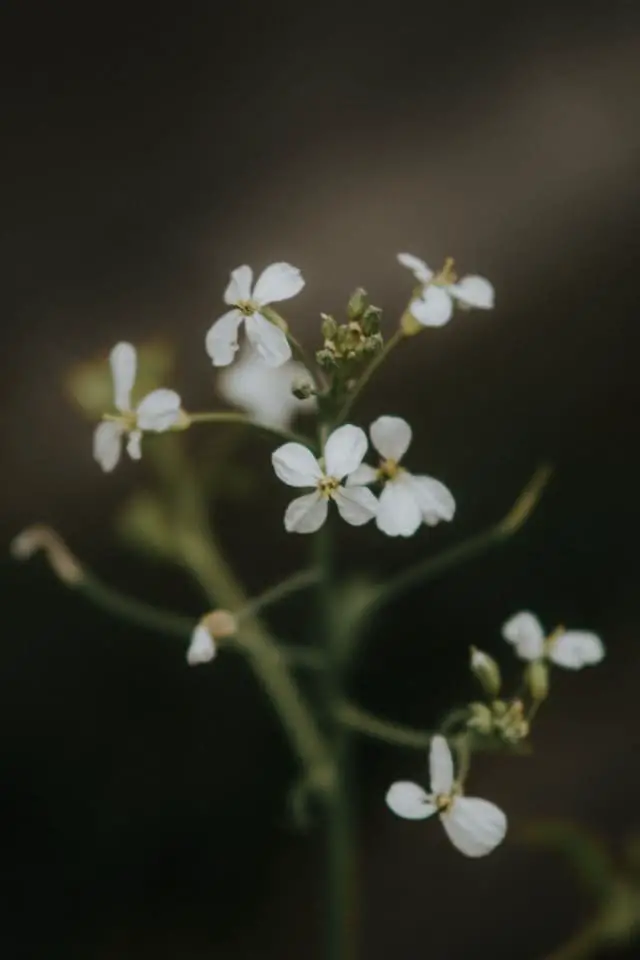
Radishes may seem like an ordinary addition to your garden, but they’re actually a valuable tool in managing aphids organically. By planting radishes alongside other crops, you can create a decoy that lures these pests away from your prized plants, reducing the need for chemical pesticides and promoting a healthier ecosystem. This natural approach is not only effective, but also cleverly uses the aphids’ preferences against them.
The fast-growing nature of radishes, combined with their tender leaves, makes them an ideal target for these pesky insects. By intentionally cultivating radishes near susceptible crops, you can concentrate the aphid population on the radishes and spare other plants in the vicinity. This simple yet effective strategy showcases the resourcefulness of gardeners, who are able to turn a pest’s strength into their own advantage.
Incorporating radishes as a trap crop is straightforward: simply sow radish seeds around your garden, particularly near areas where aphids tend to congregate. By doing so, you’ll create a buffer zone that attracts aphids away from other plants, minimizing the need for chemical pesticides and supporting a more sustainable approach to pest control.
The Dual Purpose of Radishes
Radishes not only serve as an effective trap crop to outsmart aphids and other pests, but they also bring a burst of flavor and nutrition to the kitchen table. By harvesting them early in their growth cycle, you can enjoy a crunchy, peppery snack while still reaping the benefits of their pest control properties. This dual functionality makes radishes a shrewd choice for gardeners seeking to optimize the yield and utility of their outdoor space.
Implementing Aphid-Repellent Plants in Your Garden
Creating an aphid-repellent haven in your garden is a clever move for any gardener seeking to outsmart these unwanted visitors without relying on chemicals. By strategically incorporating the right plants, you can craft a thriving oasis that’s not only visually stunning and bountiful but also equipped to withstand aphid attacks.
To achieve this harmony between nature and cultivation, let’s explore some practical approaches and expert advice for effectively integrating these plants into your garden design, thereby optimizing their repellent properties.
Strategies for Garden Layout
To effectively incorporate aphid-repellent plants into your garden, it’s crucial to adopt a thoughtful approach. The objective is to strategically position these plants to safeguard your more vulnerable crops from potential attacks. To achieve this, consider the following key strategies:
Perimeter Planting: Start by surrounding your garden with a border of aphid-repellent plants, serving as an initial barrier to deter aphids from entering your garden in the first place.
Interplanting: By incorporating these repellent plants among your other crops, you’ll be able to spread protection throughout your entire garden, creating a more comprehensive shield against aphid invasions.
Focused Protection: Target areas where your most susceptible crops are located and plant aphid-repellent varieties nearby. For instance, planting garlic or onions near roses or vegetables can help provide an added layer of protection for these more vulnerable plants.
Tips for Maximizing the Repellent Effect
When it comes to utilizing aphid-repellent plants to their full potential, timing, plant health, and diversity are crucial considerations. Here’s how you can optimize your planting strategy:
Firstly, plant your repellent plants early in the season before aphid populations reach their peak. This allows them to establish themselves and begin producing the compounds that repel aphids, providing effective protection.
Secondly, ensure that your repellent plants are healthy and vigorous.
Strong, thriving plants produce more of the essential oils and compounds that deter aphids, making them a crucial factor in their effectiveness.
Thirdly, don’t be afraid to mix things up by using a variety of repellent plants. Different species may deter different types of aphids, so having a diverse array of plants can offer broader protection against these pesky pests.
In terms of placement strategy, consider the following:
Garlic, for instance, makes an excellent perimeter and interspersed planting among vegetables, repelling aphids with its potent scent. Marigolds are also a great choice, as they confuse aphids with their scent while acting as trap crops to capture any stray pests. Basil is another excellent option, not only does it repel aphids but also enhance the health of nearby tomato plants.
By incorporating these planting techniques and placement strategies into your garden design, you’ll be well on your way to creating a thriving, aphid-free oasis.
Additional Natural Remedies to Combat Aphids
Beyond utilizing aphid-repellent plants, gardeners have access to a wealth of natural remedies that can be leveraged to combat aphid infestations. Neem oil, for instance, boasts potent properties that can help curtail aphid populations, while soap spray offers a simple yet effective solution for keeping these pesky insects under control.
Additionally, introducing beneficial insects like ladybugs into your garden ecosystem can provide an added layer of defense against aphids, eliminating the need for harsh chemicals. By incorporating these solutions into your garden management practices, you can effectively keep aphids at bay and maintain a healthy, thriving garden.
Neem Oil: The Organic Pesticide
Neem oil, extracted from the seeds of the neem tree, boasts impressive natural pest control capabilities. Its active ingredient, azadirachtin, uniquely disrupts the life cycle of pests, preventing them from multiplying and thriving. To harness its potency effectively, follow these steps: First, combine neem oil with water and a gentle detergent to enhance leaf adhesion. Then, directly spray this mixture onto affected plants, ensuring thorough coverage of both top and underside surfaces.
Timing is crucial – apply in the evening hours to spare beneficial insects and avoid damaging plant tissues from excessive sunlight. For optimal results, repeat the application every 7-14 days until the aphid infestation subsides.
Soap Spray: A Gentle Yet Effective Remedy
To combat aphid infestations in an eco-friendly manner, consider utilizing a soap spray. This approach involves dissolving 1 to 2 tablespoons of pure liquid soap in a gallon of water, taking care not to exceed the recommended proportions as excessive soap can be detrimental to plant health. The resulting mixture should then be applied directly onto the aphids, ideally during early morning or late day hours.
For optimal results, reapply the spray every few days until the aphid population dwindles to zero.
Introducing Beneficial Insects: Nature’s Pest Control
By incorporating beneficial insects like ladybugs, lacewings, and parasitic wasps into your garden, you can naturally regulate aphid populations. These tiny predators feed on aphids, offering a sustainable solution for pest control that harmoniously integrates with the ecosystem of your garden.
To attract these helpful insects, consider planting flowers such as marigolds, dill, and fennel in your garden.
Alternatively, you can purchase ladybugs or other beneficial insects from local nurseries or online retailers. When introducing new inhabitants to your garden, ensure that the evening or early morning hours are suitable for release, and provide a welcoming environment with ample water and food sources, such as aphids, to keep them thriving.
Beyond introducing these beneficial insects, you can also employ natural methods of pest control like Neem Oil.
This botanical spray effectively disrupts pests’ life cycles while being gentle on your plants. Another option is using Soap Spray directly on aphids, which dehydrates and kills them without causing harm to the surrounding vegetation. These eco-friendly approaches not only eliminate unwanted guests but also promote biodiversity within your garden.
Conclusion
As the journey to discover the importance of using aphid-repellent plants comes full circle, it’s clear that these natural wonders offer a powerful strategy for protecting our gardens. From the pungent aroma of garlic to the vibrant colors of marigolds, these plants serve as a testament to nature’s own pest management solutions.
By incorporating them into our garden designs, we not only shield our green spaces from aphid invasions but also invite a diverse and thriving ecosystem to flourish right in our backyards. This holistic approach to pest management isn’t just about fighting off aphids; it’s about changing our perspective on gardening itself. Embracing methods that align with nature’s rhythms and cycles invites a symphony of life into our gardens, where every plant, insect, and microorganism plays a vital role.
In addition to using natural remedies like neem oil and soap spray, we can also strategically introduce beneficial insects like ladybugs to further enhance this balance, creating a garden that’s not only resilient but truly alive. This approach goes beyond mere pest control; it’s about crafting a space that nurtures and sustains a vast array of life, offering refuge and sustenance to both plants and pollinators alike. It speaks to the heart of what gardening is truly about: connection.
Connection to the earth, to the cycles of life, and to the intricate web of beings that call our gardens home. As we tend our gardens, let’s do so with mindfulness and respect for the delicate balance of nature. Let’s choose plants that repel aphids naturally, apply solutions that harm neither earth nor insects, and create spaces that are not just gardens, but sanctuaries. In this way, we don’t just grow plants; we cultivate harmony, both within our gardens and within ourselves.
References
As you embark on the journey to integrate natural pest control methods and companion planting strategies into your garden, you’ll discover it’s not only rewarding but also enlightening. For those eager to delve deeper into these practices, we’ve curated a list of resources that can expand your knowledge and inspire your gardening approach.
Among the recommended readings are ‘Attracting Beneficial Bugs to Your Garden: A Natural Approach to Pest Control’ by Jessica Walliser.
This book provides valuable insights on how gardeners can transform their gardens into havens for beneficial insects, naturally reducing pest populations. Another must-read is ‘Companion Planting for the Kitchen Gardener: Tips, Advice, and Garden Plans for a Healthy Organic Garden’ by Allison Greer. Her guide to companion planting offers practical advice on pairing plants for better growth, pest control, and pollination.
For a comprehensive approach, turn to ‘The Organic Gardener’s Handbook of Natural Pest and Disease Control: A Complete Guide to Maintaining a Healthy Garden and Yard the Earth-Friendly Way’ by Fern Marshall Bradley, Barbara W. Ellis, and Deborah L. Martin. This resource covers a wide range of natural strategies for managing pests and diseases in your garden.
The ‘Neem: A Tree for Solving Global Problems’ report by the National Research Council is another valuable read.
This report delves into the various uses of neem, including its potential as a natural pesticide.
While not exclusively about pest control, ‘Gaia’s Garden: A Guide to Home-Scale Permaculture’ by Toby Hemenway introduces readers to permaculture principles that include designing gardens that mimic natural ecosystems for health, productivity, and pest management.
For those looking to conserve beneficial insects, the Xerces Society for Invertebrate Conservation (https://xerces.
org/) offers resources on creating habitats for pollinators and natural enemies of garden pests. Rodale’s Organic Life (https://www. rodalesorganiclife. com/) provides a wealth of articles on organic gardening, including topics on natural pest control and companion planting.
Lastly, CompanionPlantingChart. com offers a searchable database of plants that shows which plants benefit from being near each other for pest control, soil health, and more.


